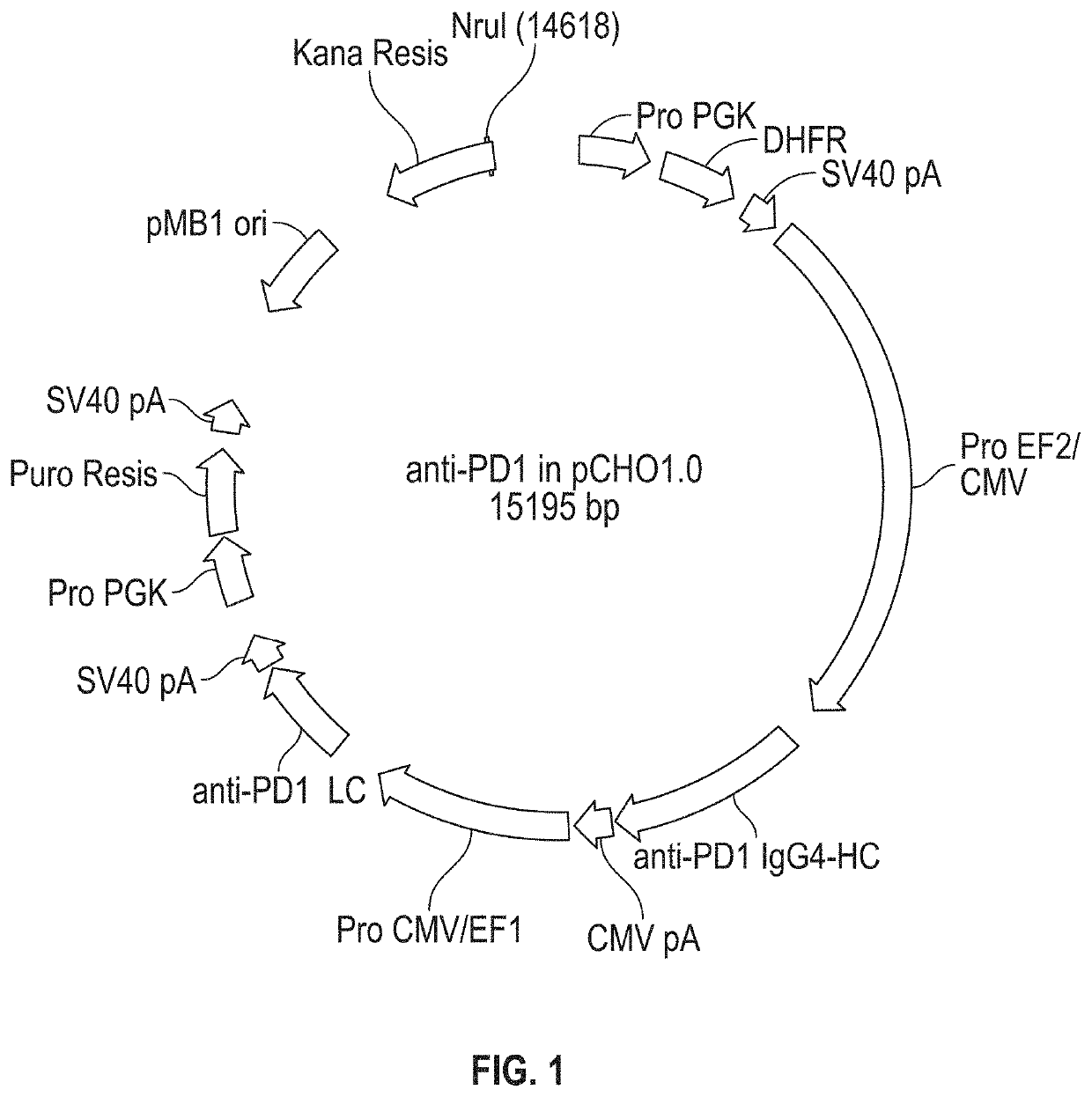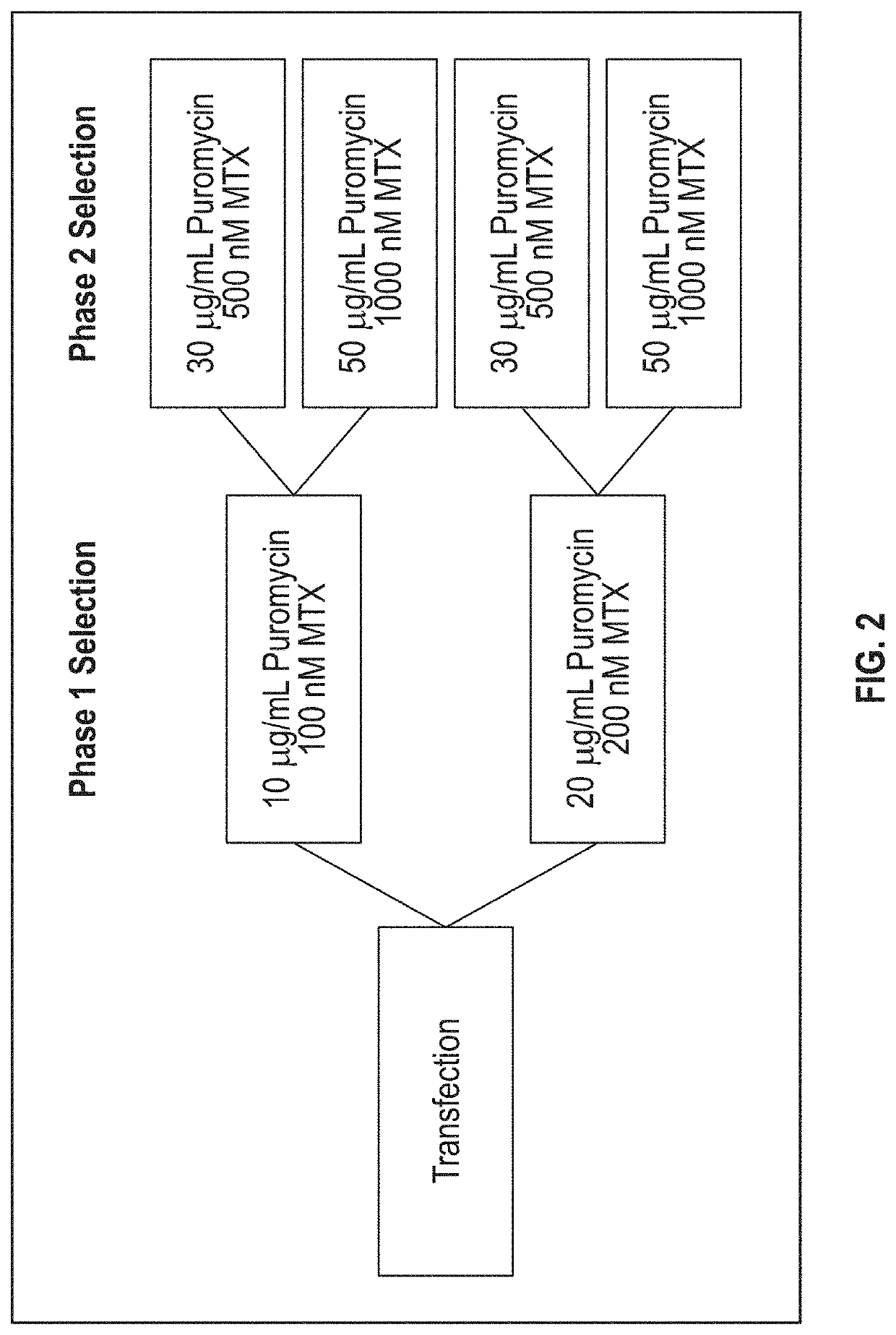Combinations of Anti-pd1 and Anti-ctla4 antibodies
a technology of anti-ctla4 and anti-pd1 is applied in the field of combination therapy of anti-ctla4 and anti-pd1 antibodies, which can solve the problems of increasing the number of fully validated targets that are amenable to developing a single effective antibody drug, increasing the difficulty of drug development, and increasing the difficulty of achieving the effect of achieving the effect of reducing the number of fully validated targets
- Summary
- Abstract
- Description
- Claims
- Application Information
AI Technical Summary
Benefits of technology
Problems solved by technology
Method used
Image
Examples
example 1
dividual Anti-hPD1 and Anti-hCTLA4 Antibodies
[0198]A single vector comprising sequences encoding the HC and LC of anti-hPD1 antibody PSB103 was created as follows. Sequences of DNA fragments encoding the amino acid sequence of SEQ ID NO: 1 and SEQ ID NO: 5 were optimized for expression in hamster (Cricetulus griseus) cells using GeneOptimizer™ online software (GeneArt, ThermoFisher Scientific). The resulting optimized DNA sequences, i.e., SEQ ID NOs: 2 and 6, were chemically synthesized. The DNA sequences encoding the HC and the LC were separately subcloned into a transient expression vector and introduced into Escherichia coli cells. The HC of this antibody contained the alteration S228P (where position 228 is as shown in Edelmann et al., supra; which corresponds to position 227 in SEQ ID NO: 1). This alteration can prevent Fab arm exchange in IgG4 antibodies. Silva et al. (2015), The S228P mutation prevents in vivo and in vitro IgG4 Fab-arm exchange as demonstrated using a combina...
example 2
the Binding Specificity of Anti-hPD1 and Anti-hCTLA4 Antibodies
[0214]The specificities of binding of the anti-hPD1 and anti-hCTLA4 antibodies, i.e., PSB103 and PSB105, were assessed by a solid phase Enzyme Linked Immuno-Sorbent Assay (ELISA) measuring binding to hPD1, hCTLA4, and other members of the CD28 family.
[0215]Briefly, 96-well, flat bottom microtiter plate wells were coated with 1 μg / mL of a capture molecule, which was either (1) the extracellular domain of human PD1 fused to an Fc fragment (hPD1.Fc), (2) the extracellular domain of human CTLA4 fused to an Fc fragment (hCTLA4.Fc), (3) the extracellular region of human PDL1 fused to a histidine-avi tag (which enables the efficient purification (histidine tag) of the protein and labeling of the protein (avi tag) with biotin) (hPDL1-his-avi), (4) the extracellular domain of murine PD1 fused to a histidine-avi tag (mPD1-his-avi), or (5) the extracellular domain of human CD28 fused to an Fc fragment (hCD28.Fc; R & D Systems catal...
example 3
se Pharmacokinetics of PSB103 and PSB105 in Cynomolgus Monkeys
[0218]Single dose pharmacokinetic properties of PSB103 in cynomolgus monkeys were assessed as follows. Two male and two female, protein naïve cynomolgus monkeys (i.e., monkeys who had not been previously dosed with a human antibody) of Cambodian origin (4.129 to 5.971 kg and 5 to 7 years of age) were placed into one of two study groups (n=2, one male and one female / group) and were acclimated to the study room for seven days prior to the start of dosing. Monkeys in one group received PSB103 and in the other group received an unrelated IgG4 antibody. PSB103 and the IgG4 antibody were injected at a dose of 5 mg / kg on Day 1 of the study by one slow intravenous (IV) bolus injection. The day prior to administration is denoted as Day −1, and days prior to that were numbered sequentially as Day −2, Day −3, etc. Days following Day 1 were numbered sequentially thereafter as Day 2, Day 3, etc. Body weights were recorded on Days −4, ...
PUM
| Property | Measurement | Unit |
|---|---|---|
| concentration | aaaaa | aaaaa |
| osmolality | aaaaa | aaaaa |
| pH | aaaaa | aaaaa |
Abstract
Description
Claims
Application Information
 Login to View More
Login to View More - R&D
- Intellectual Property
- Life Sciences
- Materials
- Tech Scout
- Unparalleled Data Quality
- Higher Quality Content
- 60% Fewer Hallucinations
Browse by: Latest US Patents, China's latest patents, Technical Efficacy Thesaurus, Application Domain, Technology Topic, Popular Technical Reports.
© 2025 PatSnap. All rights reserved.Legal|Privacy policy|Modern Slavery Act Transparency Statement|Sitemap|About US| Contact US: help@patsnap.com



